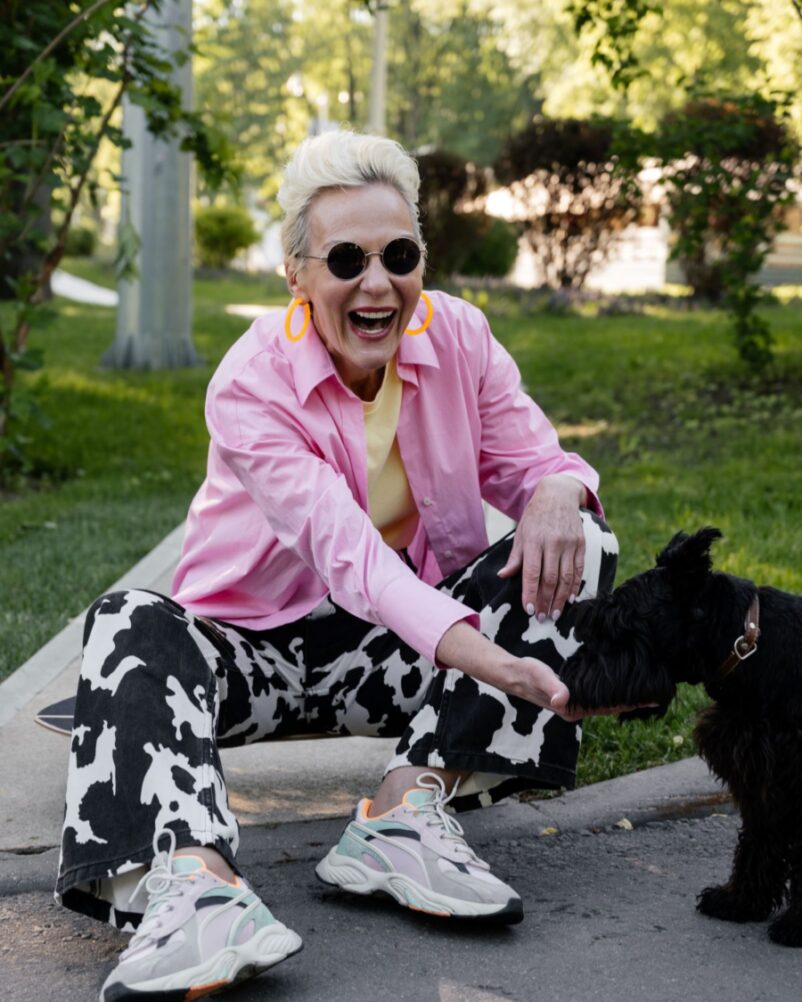
Age is one of the first things we notice about someone. Whether we mean to or not, an individual’s age (or age group) is a way we define, assess, and categorize people, and usually not in the most endearing of ways.
Ageism is real, and encompasses prejudice (how we feel), stereotypes (how we think), and discrimination (how we act) toward others and even ourselves as described by “age.”
Sometimes the bias is very deliberate. Other times, it may be somewhat unintentional. But, it’s ageism just the same. Even in casual conversations, we use ageism examples to size up how a person is doing mentally, physically, and emotionally.
How often do we hear or say statements like, “She is looking really good for her age,” “he is too told to be doing that,” or even “the years have not been kind to them.”
That is pure ageism, and according to the World Health Organization, 1 in 2 people are ageist against older people. Wow!
Ageism definition refers to the discrimination or prejudice against individuals based on how old they are. It can manifest in various forms, and ageism examples include subtly underestimating the abilities of older adults to outright exclusion and marginalization. Despite progress in promoting equality and diversity, ageism in America remains deeply ingrained in society, leading to significant negative impacts on both individuals and communities.
One powerful way discrimination manifests is through ageism in the workplace. Older employees often face challenges when seeking employment or promotions, with employers dismissing their skills and experience based solely on their age. Not only does this limit opportunities for older individuals to contribute their valuable expertise, but it also perpetuates a harmful stereotype that associates aging with diminished capabilities.
The irony of frequent ageism examples in the workplace is that recent studies have shown that older individuals over the age of 55 will fill more than 150 million jobs by 2030, according to a new global study. That equates to more than one-fourth of the workforce being older Americans who are continuing to work later in life, either because they want to or because they need to in order to make ends meet.
The sad reality of these numbers are that while most employers need–and I mean really need–the skills of older Americans, many don’t really want them in the ranks because of beliefs about their being inferior workers. And that is the absolute epitome of ageism in the workplace.
Ageism examples also impact access to healthcare by undermining the value of elderly patients’ lives and leading to inadequate medical treatment options or dismissive attitudes from caregivers.
 Also, ageism definitions perpetuate a culture that devalues the contributions of older adults to society as a whole. By marginalizing them and reinforcing stereotypes about aging being synonymous with decline or irrelevance, we are robbing ourselves of vast reserves of knowledge and wisdom that could benefit us all. Overcoming ageism requires recognizing the inherent value in every stage of life and actively challenging these entrenched biases so that we can build a more inclusive society for people of all ages.
Also, ageism definitions perpetuate a culture that devalues the contributions of older adults to society as a whole. By marginalizing them and reinforcing stereotypes about aging being synonymous with decline or irrelevance, we are robbing ourselves of vast reserves of knowledge and wisdom that could benefit us all. Overcoming ageism requires recognizing the inherent value in every stage of life and actively challenging these entrenched biases so that we can build a more inclusive society for people of all ages.
Stereotypes: Common Misconceptions About Aging
One common misconception about aging in America is that it means a decline in cognitive abilities. While it is true that some cognitive functions may slow down with age, research suggests that older adults can still excel in certain areas. In fact, studies have shown that older adults are often better at problem-solving and decision-making, thanks to their wealth of life experience and knowledge.
It is important to recognize the diverse range of abilities that individuals possess regardless of their age and avoid making sweeping assumptions about their intelligence or competence based solely on their chronological age.
Another common stereotype about aging in America is that older adults are lonely and isolated. While it is true that some seniors may experience social isolation due to factors like retirement or the loss of loved ones, many older adults have rich social lives and maintain strong relationships with family and friends.
Research also suggests that seniors who actively engage in social activities tend to experience better overall health outcomes compared to those who are socially isolated. It is crucial not to overlook the importance of maintaining strong social connections throughout all stages of life and challenge the stereotype that portrays aging as a solitary journey.
Prejudice: How Ageism Examples of Discrimination Affects Individuals
Age discrimination is a deeply ingrained form of prejudice that affects individuals in various ways. One notable impact of ageism in the workplace is the limited career opportunities available to older individuals. Despite their experience and knowledge, older workers often find themselves overlooked for promotions or even excluded from job interviews altogether, solely based on their age. This perpetuates the stereotype that older people are less capable or adaptable, contributing to a cycle of discrimination that can be difficult to break.
Another consequence of ageism examples is the undermining of an individual’s worth and value in society. Older adults may face social isolation or feel marginalized due to stereotypes and prejudiced attitudes. This can lead to decreased self-esteem and quality of life, as they are made to feel invisible or irrelevant by a society obsessed with youthfulness.
Ageism not only restricts opportunities but also devalues the contributions and wisdom that older individuals possess, robbing society as a whole of valuable resources and perspectives.
Age bias has far-reaching effects on individuals’ lives, hindering career advancement and contributing to social marginalization. It’s crucial for society to recognize these prejudices and actively work towards creating an inclusive environment where people of all ages are valued and given equal opportunities for success.
By breaking down these barriers, we can begin to challenge long-held stereotypes and embrace the diversity and richness that every generation brings.
Discrimination: Ageism Examples in Different Settings
Ageism examples are not limited to professional environments or healthcare settings. Even in social circles, we witness instances where older adults are automatically excluded from social gatherings or dismissed because they are deemed less interesting or fun compared to their younger counterparts.
Age should never be a criterion for determining an individual’s worth or capabilities; yet society continues to perpetuate such discriminatory behaviors that harm individuals’ dignity and overall well-being.
Raising awareness about these examples of ageist practices across various settings is crucial if we want to challenge stereotypes, prejudice, and discrimination associated with aging populations. By promoting inclusivity and valuing individuals based on their merits rather than their chronological age alone, we can create a more equitable society that respects and appreciates people of all ages for their unique contributions.
The Effects of Ageism Examples on Mental Health
Ageism definition—the discrimination or prejudice based on a person’s age—has significant effects on mental health that are often overlooked. Older adults who experience ageism may begin to internalize these negative stereotypes and feel a diminished sense of self-worth. This can lead to feelings of depression, anxiety, and social isolation. Furthermore, studies have shown that experiencing ageism can also contribute to cognitive decline and even increase the risk of developing Alzheimer’s disease.

Additionally, ageism examples can have profound effects on older adults’ access to healthcare services and resources. When assumptions are made about their abilities based solely on their age, older adults may be denied necessary medical treatments or interventions. This not only impacts their physical health but also takes a toll on their mental well-being as they may feel disregarded or devalued by society.
It is essential for society to recognize and challenge ageist attitudes in order to promote positive mental health outcomes for older adults. By fostering inclusivity and respect across all generations, we can create an environment where individuals of all ages are valued for their unique contributions and perspectives.
Additionally, healthcare providers need to be aware of the potential effects of ageism on mental health and actively work towards providing equitable care regardless of age. Only through these collective efforts can we combat the damaging effects of ageism on mental health and ensure a more inclusive society for future generations.
Older Workers Are Changing the Scope of the Global Workforce
An aging workforce is certainly not an American-only concern. Japan already has almost 40 percent of its workforce over the age of 55. Europe and the U.S. are not that far behind, with estimates ranging from 25 to 35 percent of older workers. China’s population in general is shifting as well, which will influence its workforce. The country’s elderly population (age 65 and up) will more than double by 2050.
In order to combat ageism examples worldwide, a multifaceted approach is necessary. The first step is education: raising awareness about the issue and challenging the stereotypes and prejudices associated with aging. This can be done through public campaigns, educational programs in schools and workplaces, as well as media initiatives that promote positive images of older adults.
Another key strategy is promoting intergenerational connections and collaboration. By fostering meaningful interactions between different age groups, we can create opportunities for understanding and empathy. Intergenerational programs that bring together older adults and youth have been shown to not only decrease ageist attitudes but also enhance social cohesion within communities.
Finally, it is imperative to advocate for legislative changes that protect older adults from discrimination. This includes implementing policies that enforce equal employment opportunities for people of all ages, providing affordable healthcare options, and strengthening laws against age-based harassment or mistreatment.
By addressing ageism head-on with these strategies, we can work towards creating a society where individuals are valued for their contributions regardless of their age. Let’s challenge our own biases, foster intergenerational bonds, and fight for a future free of discrimination based on age.
Or better yet, let’s work on being a discrimination-free world in general!
Check out these 3 related articles on aging and ageism. Remember, we are only as old as we feel!
- Senior Citizen Age: Is There A Seniorhood Start Date?
- Debunking 11 Tired Stereotypes and Myths About Aging
- The Art of Aging Gracefully: Simple Secrets Revealed
Written by
Robin McClure
Robin is the author of 7 parenting books and has 3 grown children, 3 spoiled rescue dogs, and a very understanding husband. She holds a bachelor's degree in journalism and a master's degree in communications, and spends her time writing, drinking coffee, and planning the next grand adventure.



